coolant level CHEVROLET HHR 2007 1.G Owners Manual
[x] Cancel search | Manufacturer: CHEVROLET, Model Year: 2007, Model line: HHR, Model: CHEVROLET HHR 2007 1.GPages: 446, PDF Size: 2.43 MB
Page 188 of 446
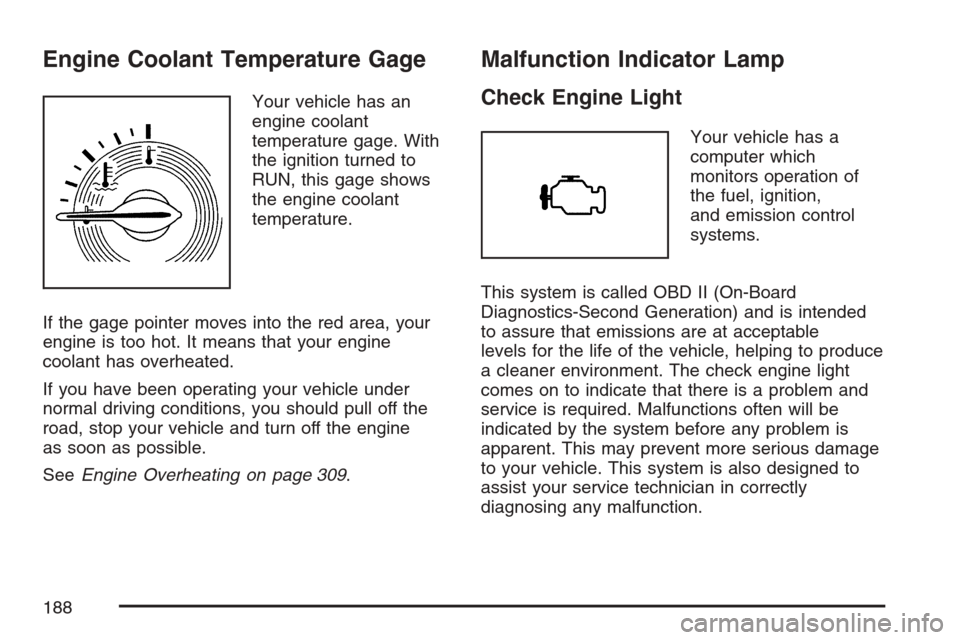
Engine Coolant Temperature Gage
Your vehicle has an
engine coolant
temperature gage. With
the ignition turned to
RUN, this gage shows
the engine coolant
temperature.
If the gage pointer moves into the red area, your
engine is too hot. It means that your engine
coolant has overheated.
If you have been operating your vehicle under
normal driving conditions, you should pull off the
road, stop your vehicle and turn off the engine
as soon as possible.
SeeEngine Overheating on page 309.
Malfunction Indicator Lamp
Check Engine Light
Your vehicle has a
computer which
monitors operation of
the fuel, ignition,
and emission control
systems.
This system is called OBD II (On-Board
Diagnostics-Second Generation) and is intended
to assure that emissions are at acceptable
levels for the life of the vehicle, helping to produce
a cleaner environment. The check engine light
comes on to indicate that there is a problem and
service is required. Malfunctions often will be
indicated by the system before any problem is
apparent. This may prevent more serious damage
to your vehicle. This system is also designed to
assist your service technician in correctly
diagnosing any malfunction.
188
Page 299 of 446
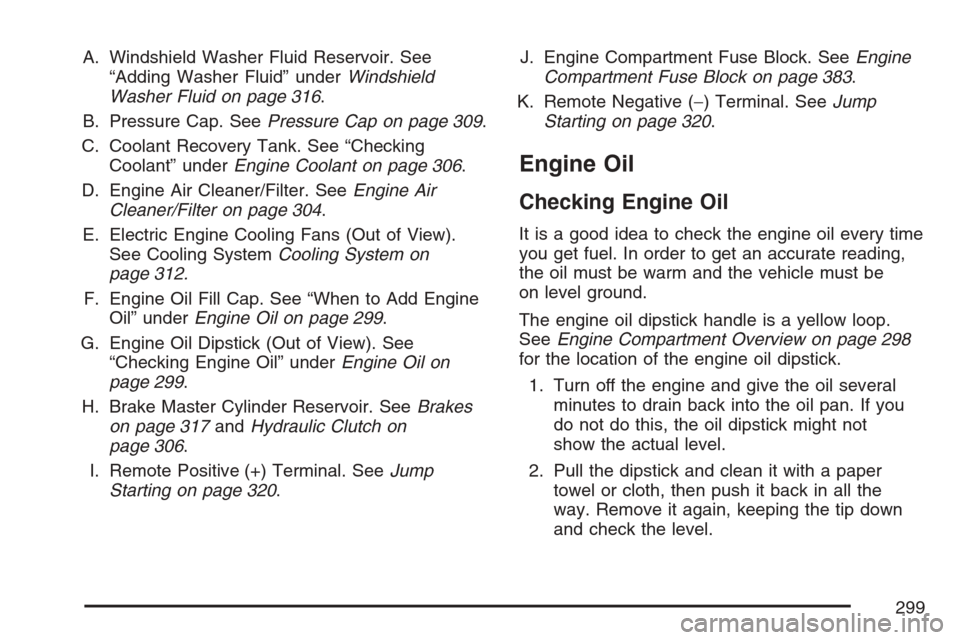
A. Windshield Washer Fluid Reservoir. See
“Adding Washer Fluid” underWindshield
Washer Fluid on page 316.
B. Pressure Cap. SeePressure Cap on page 309.
C. Coolant Recovery Tank. See “Checking
Coolant” underEngine Coolant on page 306.
D. Engine Air Cleaner/Filter. SeeEngine Air
Cleaner/Filter on page 304.
E. Electric Engine Cooling Fans (Out of View).
See Cooling SystemCooling System on
page 312.
F. Engine Oil Fill Cap. See “When to Add Engine
Oil” underEngine Oil on page 299.
G. Engine Oil Dipstick (Out of View). See
“Checking Engine Oil” underEngine Oil on
page 299.
H. Brake Master Cylinder Reservoir. SeeBrakes
on page 317andHydraulic Clutch on
page 306.
I. Remote Positive (+) Terminal. SeeJump
Starting on page 320.J. Engine Compartment Fuse Block. SeeEngine
Compartment Fuse Block on page 383.
K. Remote Negative (−) Terminal. SeeJump
Starting on page 320.
Engine Oil
Checking Engine Oil
It is a good idea to check the engine oil every time
you get fuel. In order to get an accurate reading,
the oil must be warm and the vehicle must be
on level ground.
The engine oil dipstick handle is a yellow loop.
SeeEngine Compartment Overview on page 298
for the location of the engine oil dipstick.
1. Turn off the engine and give the oil several
minutes to drain back into the oil pan. If you
do not do this, the oil dipstick might not
show the actual level.
2. Pull the dipstick and clean it with a paper
towel or cloth, then push it back in all the
way. Remove it again, keeping the tip down
and check the level.
299
Page 308 of 446
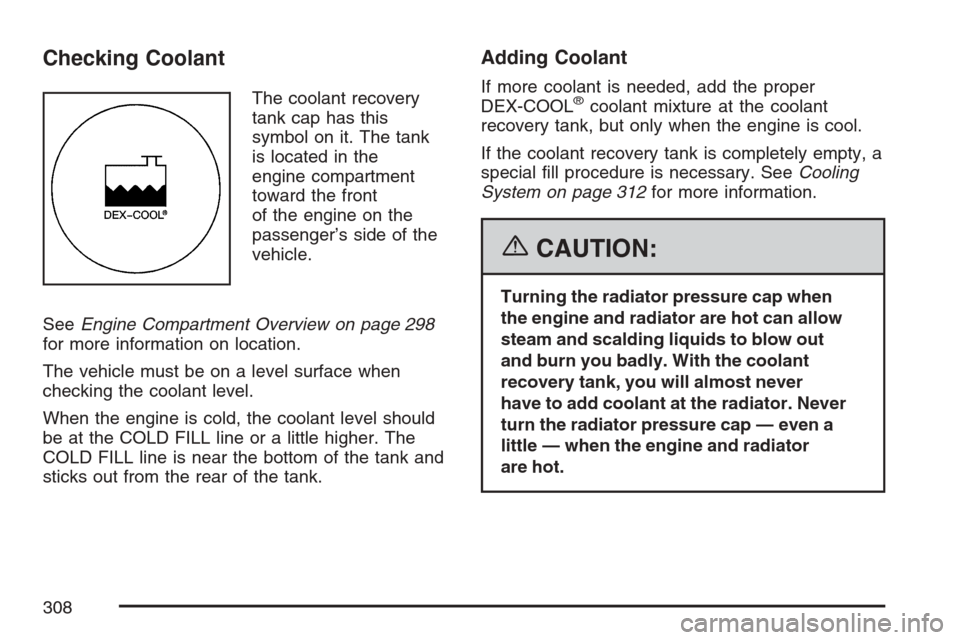
Checking Coolant
The coolant recovery
tank cap has this
symbol on it. The tank
is located in the
engine compartment
toward the front
of the engine on the
passenger’s side of the
vehicle.
SeeEngine Compartment Overview on page 298
for more information on location.
The vehicle must be on a level surface when
checking the coolant level.
When the engine is cold, the coolant level should
be at the COLD FILL line or a little higher. The
COLD FILL line is near the bottom of the tank and
sticks out from the rear of the tank.
Adding Coolant
If more coolant is needed, add the proper
DEX-COOL®coolant mixture at the coolant
recovery tank, but only when the engine is cool.
If the coolant recovery tank is completely empty, a
special �ll procedure is necessary. SeeCooling
System on page 312for more information.
{CAUTION:
Turning the radiator pressure cap when
the engine and radiator are hot can allow
steam and scalding liquids to blow out
and burn you badly. With the coolant
recovery tank, you will almost never
have to add coolant at the radiator. Never
turn the radiator pressure cap — even a
little — when the engine and radiator
are hot.
308
Page 312 of 446
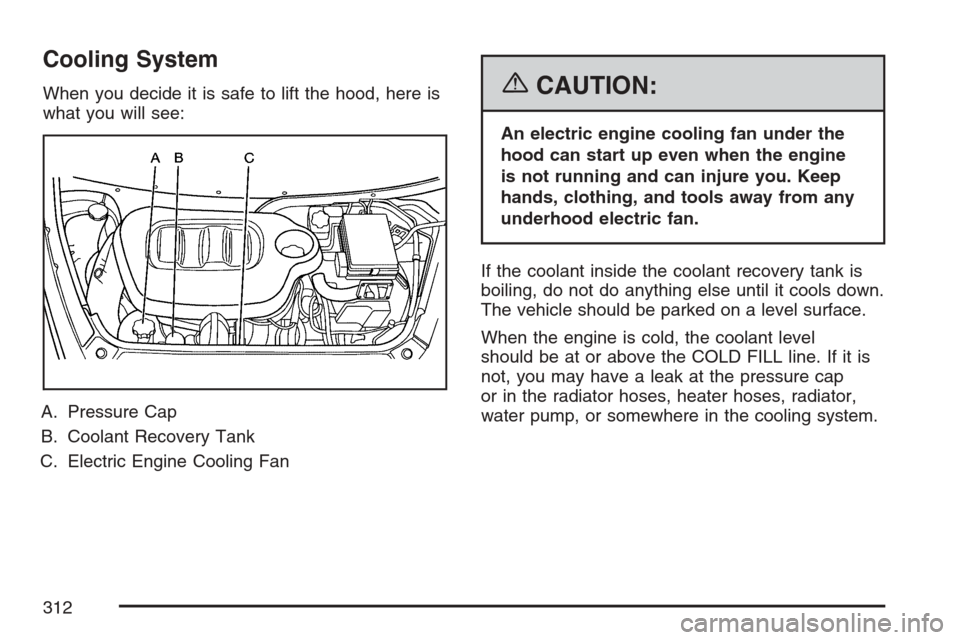
Cooling System
When you decide it is safe to lift the hood, here is
what you will see:
A. Pressure Cap
B. Coolant Recovery Tank
C. Electric Engine Cooling Fan{CAUTION:
An electric engine cooling fan under the
hood can start up even when the engine
is not running and can injure you. Keep
hands, clothing, and tools away from any
underhood electric fan.
If the coolant inside the coolant recovery tank is
boiling, do not do anything else until it cools down.
The vehicle should be parked on a level surface.
When the engine is cold, the coolant level
should be at or above the COLD FILL line. If it is
not, you may have a leak at the pressure cap
or in the radiator hoses, heater hoses, radiator,
water pump, or somewhere in the cooling system.
312
Page 313 of 446
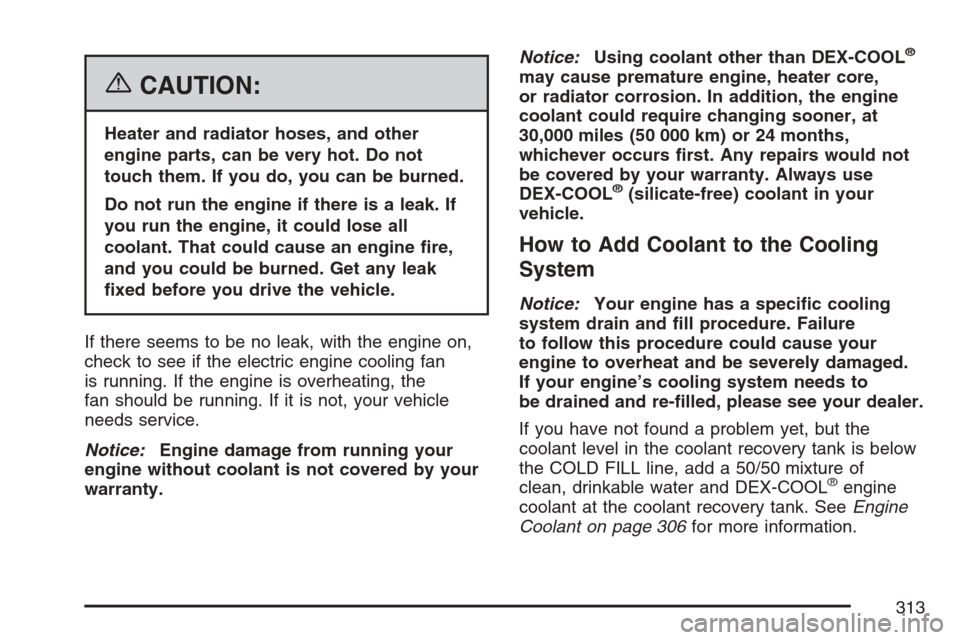
{CAUTION:
Heater and radiator hoses, and other
engine parts, can be very hot. Do not
touch them. If you do, you can be burned.
Do not run the engine if there is a leak. If
you run the engine, it could lose all
coolant. That could cause an engine �re,
and you could be burned. Get any leak
�xed before you drive the vehicle.
If there seems to be no leak, with the engine on,
check to see if the electric engine cooling fan
is running. If the engine is overheating, the
fan should be running. If it is not, your vehicle
needs service.
Notice:Engine damage from running your
engine without coolant is not covered by your
warranty.Notice:Using coolant other than DEX-COOL
®
may cause premature engine, heater core,
or radiator corrosion. In addition, the engine
coolant could require changing sooner, at
30,000 miles (50 000 km) or 24 months,
whichever occurs �rst. Any repairs would not
be covered by your warranty. Always use
DEX-COOL
®(silicate-free) coolant in your
vehicle.
How to Add Coolant to the Cooling
System
Notice:Your engine has a speci�c cooling
system drain and �ll procedure. Failure
to follow this procedure could cause your
engine to overheat and be severely damaged.
If your engine’s cooling system needs to
be drained and re-�lled, please see your dealer.
If you have not found a problem yet, but the
coolant level in the coolant recovery tank is below
the COLD FILL line, add a 50/50 mixture of
clean, drinkable water and DEX-COOL
®engine
coolant at the coolant recovery tank. SeeEngine
Coolant on page 306for more information.
313
Page 316 of 446
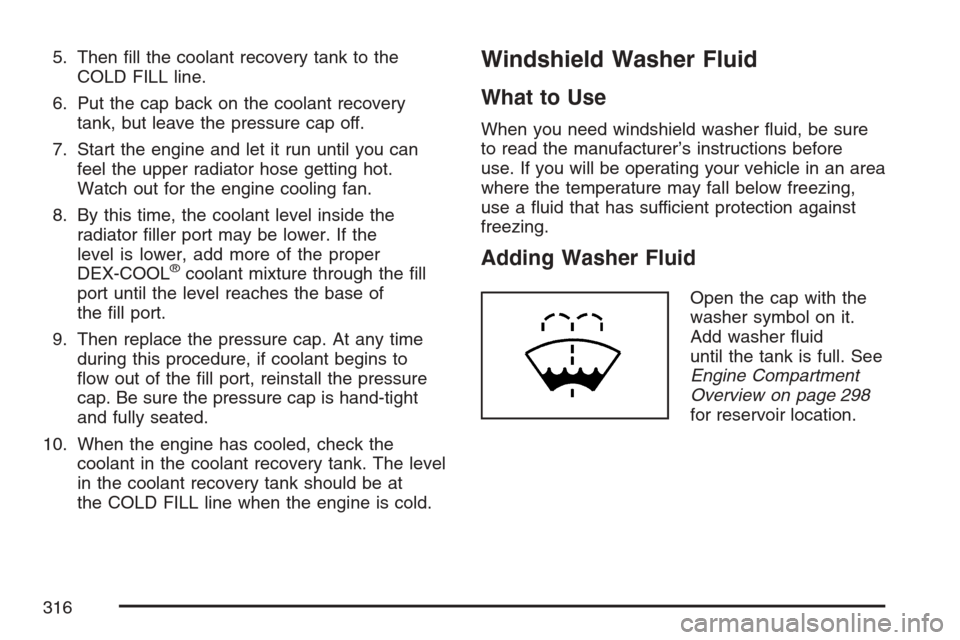
5. Then �ll the coolant recovery tank to the
COLD FILL line.
6. Put the cap back on the coolant recovery
tank, but leave the pressure cap off.
7. Start the engine and let it run until you can
feel the upper radiator hose getting hot.
Watch out for the engine cooling fan.
8. By this time, the coolant level inside the
radiator �ller port may be lower. If the
level is lower, add more of the proper
DEX-COOL
®coolant mixture through the �ll
port until the level reaches the base of
the �ll port.
9. Then replace the pressure cap. At any time
during this procedure, if coolant begins to
�ow out of the �ll port, reinstall the pressure
cap. Be sure the pressure cap is hand-tight
and fully seated.
10. When the engine has cooled, check the
coolant in the coolant recovery tank. The level
in the coolant recovery tank should be at
the COLD FILL line when the engine is cold.
Windshield Washer Fluid
What to Use
When you need windshield washer �uid, be sure
to read the manufacturer’s instructions before
use. If you will be operating your vehicle in an area
where the temperature may fall below freezing,
use a �uid that has sufficient protection against
freezing.
Adding Washer Fluid
Open the cap with the
washer symbol on it.
Add washer �uid
until the tank is full. See
Engine Compartment
Overview on page 298
for reservoir location.
316
Page 317 of 446
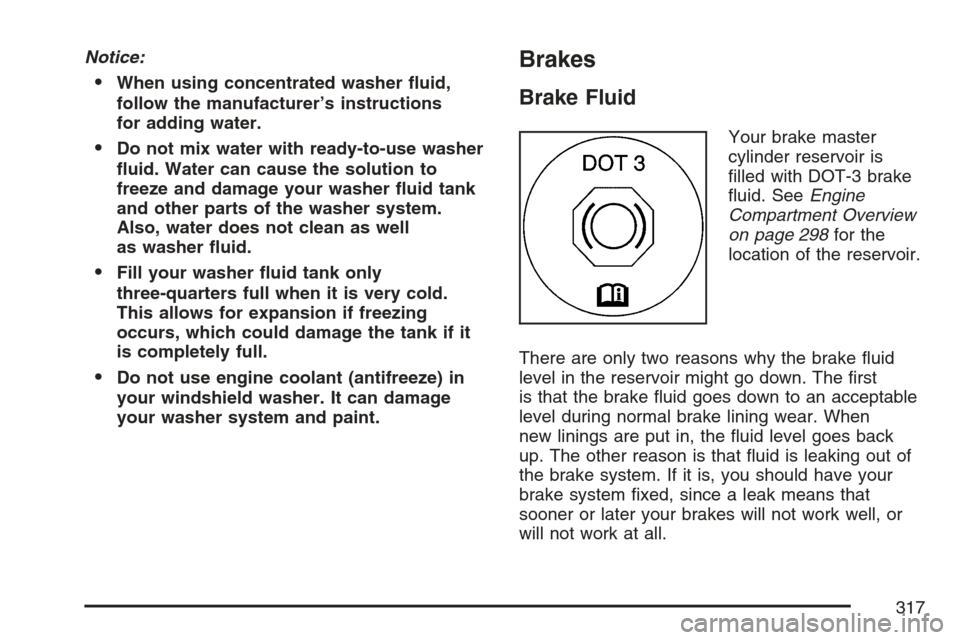
Notice:
When using concentrated washer �uid,
follow the manufacturer’s instructions
for adding water.
Do not mix water with ready-to-use washer
�uid. Water can cause the solution to
freeze and damage your washer �uid tank
and other parts of the washer system.
Also, water does not clean as well
as washer �uid.
Fill your washer �uid tank only
three-quarters full when it is very cold.
This allows for expansion if freezing
occurs, which could damage the tank if it
is completely full.
Do not use engine coolant (antifreeze) in
your windshield washer. It can damage
your washer system and paint.
Brakes
Brake Fluid
Your brake master
cylinder reservoir is
�lled with DOT-3 brake
�uid. SeeEngine
Compartment Overview
on page 298for the
location of the reservoir.
There are only two reasons why the brake �uid
level in the reservoir might go down. The �rst
is that the brake �uid goes down to an acceptable
level during normal brake lining wear. When
new linings are put in, the �uid level goes back
up. The other reason is that �uid is leaking out of
the brake system. If it is, you should have your
brake system �xed, since a leak means that
sooner or later your brakes will not work well, or
will not work at all.
317
Page 395 of 446
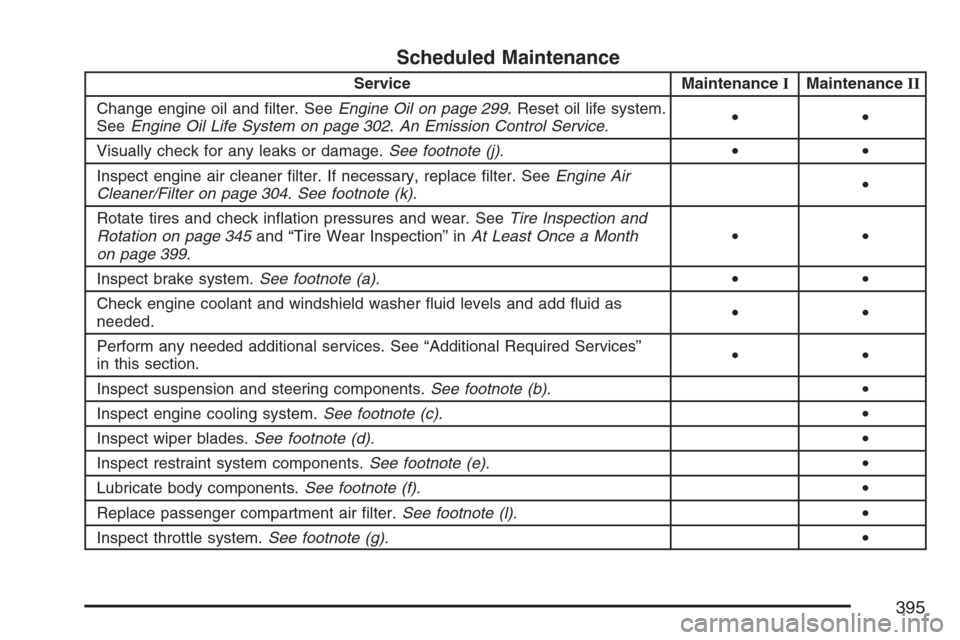
Scheduled Maintenance
Service MaintenanceIMaintenanceII
Change engine oil and �lter. SeeEngine Oil on page 299. Reset oil life system.
SeeEngine Oil Life System on page 302.An Emission Control Service.••
Visually check for any leaks or damage.See footnote (j).••
Inspect engine air cleaner �lter. If necessary, replace �lter. SeeEngine Air
Cleaner/Filter on page 304.See footnote (k).•
Rotate tires and check in�ation pressures and wear. SeeTire Inspection and
Rotation on page 345and “Tire Wear Inspection” inAt Least Once a Month
on page 399.••
Inspect brake system.See footnote (a).••
Check engine coolant and windshield washer �uid levels and add �uid as
needed.••
Perform any needed additional services. See “Additional Required Services”
in this section.••
Inspect suspension and steering components.See footnote (b).•
Inspect engine cooling system.See footnote (c).•
Inspect wiper blades.See footnote (d).•
Inspect restraint system components.See footnote (e).•
Lubricate body components.See footnote (f).•
Replace passenger compartment air �lter.See footnote (l).•
Inspect throttle system.See footnote (g).•
395
Page 398 of 446
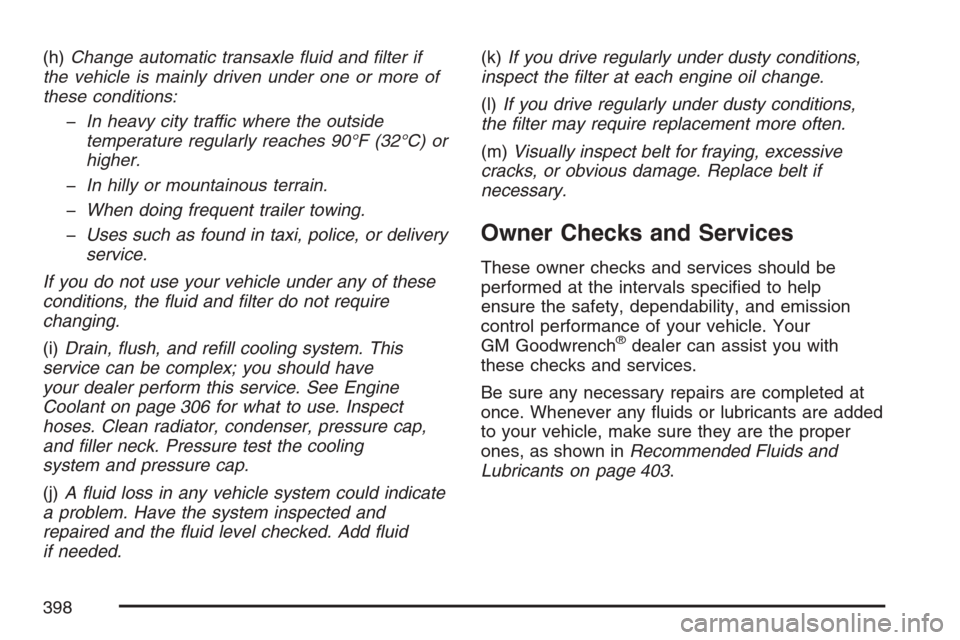
(h)Change automatic transaxle fluid and filter if
the vehicle is mainly driven under one or more of
these conditions:
�In heavy city traffic where the outside
temperature regularly reaches 90°F (32°C) or
higher.
�In hilly or mountainous terrain.
�When doing frequent trailer towing.
�Uses such as found in taxi, police, or delivery
service.
If you do not use your vehicle under any of these
conditions, the fluid and filter do not require
changing.
(i)Drain, flush, and refill cooling system. This
service can be complex; you should have
your dealer perform this service. See Engine
Coolant on page 306 for what to use. Inspect
hoses. Clean radiator, condenser, pressure cap,
and filler neck. Pressure test the cooling
system and pressure cap.
(j)A fluid loss in any vehicle system could indicate
a problem. Have the system inspected and
repaired and the fluid level checked. Add fluid
if needed.(k)If you drive regularly under dusty conditions,
inspect the filter at each engine oil change.
(l)If you drive regularly under dusty conditions,
the filter may require replacement more often.
(m)Visually inspect belt for fraying, excessive
cracks, or obvious damage. Replace belt if
necessary.
Owner Checks and Services
These owner checks and services should be
performed at the intervals speci�ed to help
ensure the safety, dependability, and emission
control performance of your vehicle. Your
GM Goodwrench
®dealer can assist you with
these checks and services.
Be sure any necessary repairs are completed at
once. Whenever any �uids or lubricants are added
to your vehicle, make sure they are the proper
ones, as shown inRecommended Fluids and
Lubricants on page 403.
398
Page 399 of 446
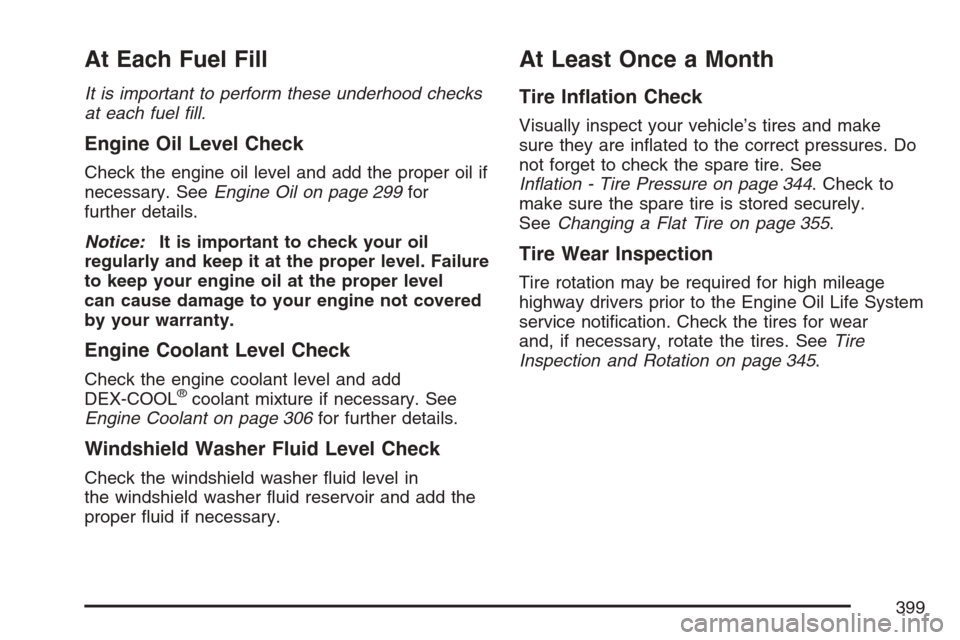
At Each Fuel Fill
It is important to perform these underhood checks
at each fuel fill.
Engine Oil Level Check
Check the engine oil level and add the proper oil if
necessary. SeeEngine Oil on page 299for
further details.
Notice:It is important to check your oil
regularly and keep it at the proper level. Failure
to keep your engine oil at the proper level
can cause damage to your engine not covered
by your warranty.
Engine Coolant Level Check
Check the engine coolant level and add
DEX-COOL®coolant mixture if necessary. See
Engine Coolant on page 306for further details.
Windshield Washer Fluid Level Check
Check the windshield washer �uid level in
the windshield washer �uid reservoir and add the
proper �uid if necessary.
At Least Once a Month
Tire In�ation Check
Visually inspect your vehicle’s tires and make
sure they are in�ated to the correct pressures. Do
not forget to check the spare tire. See
Inflation - Tire Pressure on page 344. Check to
make sure the spare tire is stored securely.
SeeChanging a Flat Tire on page 355.
Tire Wear Inspection
Tire rotation may be required for high mileage
highway drivers prior to the Engine Oil Life System
service noti�cation. Check the tires for wear
and, if necessary, rotate the tires. SeeTire
Inspection and Rotation on page 345.
399